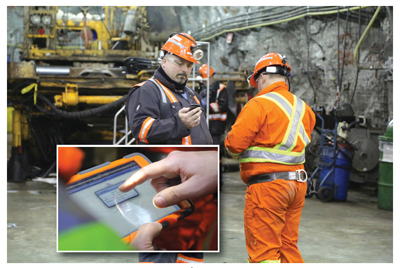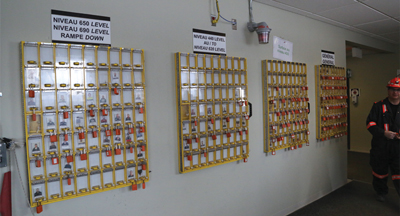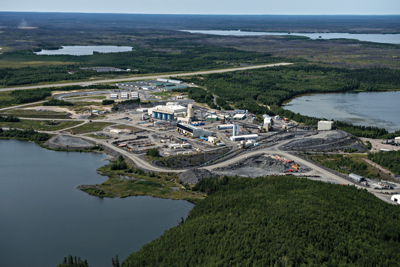Goldcorp finds innovative ways to improve safety and lower costs
By Steve Fiscor, Editor-in-Chief
 |
| Goldcorp’s Éléonore mine, a new underground gold mine located in Canada’s James Bay region, is using technology to improve safety and reduce production costs. |
Goldcorp is one of the fastest growing gold producers. With eight operations throughout the Americas, the company constantly seeks safety and productivity improvements for its mines and mills. In 2013, Goldcorp launched its Operating for Excellence (O4E) program, which focuses on cost-cutting and production efficiencies. They took it a step further in 2014, creating the Global Excellence Awards, which also recognize achievement in several areas, such as safety, environment, corporate social responsibility and production.
With the steady decline in metal prices during the last three years, gold miners must find ways to cut costs. Goldcorp’s focus on improving operating efficiencies helped it maintain profitability, explained George Burns, COO, Goldcorp. “Last year, we had cash flow improvements totaling approximately $275 million related to these operating efficiency projects,” Burns said. “Some of these projects increased revenue, while others reduced operating costs.”
Annually, the mines nominate projects and the company gives awards, flying winners to the company’s headquarters in Vancouver for a celebration. “The awards event creates an environment where people feel good about what we have accomplished as an organization,” Burns said. “It gets people excited about the cool things we are doing and also teases out new ideas.”
Some of the innovative solutions that have bubbled to the surface include ventilation on demand, automated truck haulage and a concentrate enrichment program. Goldcorp is implementing the latest tools and technology at new mines and also applying that experience to existing operations. “In many cases, we are taking existing technology and applying it to our systems, which makes us more efficient,” Burns said. “In addition to the outside support, we have the organic O4E solutions where managers at the mines and mills are making incremental improvements. We are not looking for a bunch of new patented inventions from our team like we did with the patent pending on the Concentrate Enrichment Process. If one of our technical people develops something new, we will support it, but that’s not the main focus of this program.”
In a way, Goldcorp’s older mines are re-inventing themselves with a focus on financial discipline improving cash flow and profitability. The work they are completing this year will turn into capital requests that will afford the opportunity to improve margins and/or increase safe production at existing operations.
INNOVATIONS AT ÉLÉONORE
Working with the Cree Nation of Wemindji, Goldcorp has developed the Éléonore mine in Canada’s James Bay region. An underground operation with a long mine life, the mine achieved commercial production April 1. The company is anticipating gold production to ramp up from approximately 300,000 oz in 2015 to approximately 500,000 oz/y over the next several years. Because it’s a new mine, Goldcorp had the opportunity to apply the latest technology from the onset. The mine uses a wireless communications network to constantly communicate with and track miners and equipment underground. The mine’s communications backbone is a combination of fiber optics and leaky feeder system that relies on nodes in the extremities to transmit data to and from the surface. Communications and tracking systems are not new, but the way Goldcorp has integrated it with other processes is a fundamental change that enables many opportunities for improvements.
One of the biggest power consumers for any underground mine is the ventilation system, which pulls air through the mine bringing fresh air to miners and removing harmful emissions. Using the communications and tracking system, they are able to turn the fans off or ramp them up as necessary. As an example, if two miners were walking down a drift and decided to turn down a cross cut, the system would recognize that they were entering that area, a fan would turn on and deliver enough air for the two miners in that heading. When an LHD arrives, the fan increases ventilation to compensate for the diesel engine emissions. As they and the equipment leave the area, the system would dial down and eventually turn itself off.
 |
| Miners use devices underground to connect to Éléonore’s wireless communications network. (Photos courtesy of Cisco) |
“Ordinarily, underground ventilation systems draw air through the mine at a high level and the miners use various controls to direct air to the active areas,” Burns said. “Thanks to this intelligent system, we will spend a lot less money on electricity related to ventilation than we normally would.”
The communications network also allows production managers and maintenance personnel to work with wireless-enabled devices. “They can communicate a lot more easily and instantaneously back to the surface,” Burns said. “We are exploring all of the opportunities that this would unlock for the company.”
Armed with tablets, production managers update activities regularly and so do the maintenance supervisors. Electricians have electrical drawings on tablets in the field. Typically, supervisors would fill out forms and bring them to the surface where they (or a clerk) would input the information into a computer. Now that information is input underground in real time and uploaded continuously. The same thing is happening with the equipment data. When the next crew arrives, they know exactly where the equipment is parked and its operating condition.
Éléonore uses a long-hole stoping method to mine a deep, near vertical ore body. From the surface, miners can operate scoops, long-hole drills and rock breakers using a teleremote system. The system improves safety by removing miners from the production heading and the mine continues to operate during shift change.
The mine has several levels developed and long-hole drills are used to blast ore between the levels. They are currently looking at fully automated trucks with no drivers on the haulage level. An LHD would load the truck and it would haul the load and dump it at the ore pass and then return to the loading point.
“We are automating the mining method with existing technology,” Burns said. “It’s cost effective, because some of the labor component is eliminated, but it also eliminates equipment damage. These trucks never hit the wall. They are perfect every time and they run exactly the way the manufacturer intended them to run.”
Having the ability to track everything that’s happening underground enables managers to remove bottlenecks. Once inefficiency opportunities are identified, changes can be implemented to improve productivity.
 |
| Porcupine’s padlock system replaces the traditional brass-on-the-board tracking system. |
ELIMINATING RISK AND BOTTLENECKS
As far as safety, many of these innovations are engineering out risks, Burns explained. Goldcorp is testing proximity detection on equipment at the Porcupine operation. Located near Timmins, Ontario, Porcupine consists of the Hoyle Pond and Dome underground mines, the Hollinger open-pit mine, several large tonnage low-grade stockpiles and a central milling facility. Even though it’s one of the oldest gold-producing camps in North America, today’s miners are working with leading-edge proximity detection systems. “Truck drivers have many blind spots,” Burns said. “Now the truck driver has a panel that warns him when people or equipment enters a pre-set zone. We are eliminating the risk of haulage-related accidents.”
Innovations are not always dependent on sophisticated technology. Burns discussed a relatively simple innovation that has improved safety. Anyone who has worked underground is familiar with the brass used to tag in and out of the mine. “A blasting foreman is not supposed to initiate a blast if there’s brass on the board,” Burns said. “People make mistakes and there have been near misses at many mines around the world.”
Goldcorp’s vice president of operations for the Quebec region challenged the miners to eliminate that risk. The solution they settled on was padlocks to lock in and out, similar to how electricians handle electrical panels during the maintenance process. “If there is one lock on the lock out board, the blasting foreman cannot get access to the blasting key,” Burns said. “That risk is physically engineered out of the process. On top of that, the electronic tracking system gives us a second check. Between the two, we have greatly eliminated the possibility of detonating a blast with miners in harm’s way.” Goldcorp is now adapting this system at all of its underground mines. Moreover, the mine inspectors in Quebec have seen it, Burns said, and they like it so it might eventually become a law for the province.
PROCESS IMPROVEMENT AT PEÑASQUITO
Peñasquito is Mexico’s largest gold producer and a cornerstone operation for Goldcorp. In addition to the approximate 700,000-750,000 oz of gold it will produce in 2015, the operation also produces significant amounts of silver (24-26 million oz), zinc (400-415 million lb) and lead (175-185 million lb). Peñasquito produces a lead and zinc concentrate that is shipped to third-party smelters for further processing. Both of those cons contain gold and silver. “The zinc con is clean and smelting fees are relatively low. In fact, smelters want that concentrate,” Burns said. “The lead con, however, is more variable and less desirable. Some of it contains copper and other impurities, such as arsenic and antimony. Lead smelters do not like any of those elements in the feed. Processing the lead concentrate commands a premium smelting fee and the smelters keep a portion of the precious metals for themselves as a penalty.”
 |
| Metallurgists at the Peñasquito mill (above) recently devised a strategy to enrich concentrate. |
Goldcorp challenged metallurgists at Peñasquito and the corporate office, Burns explained, and they began to solve the problem. The first move was to float a copper con. “We’re paying a penalty on the copper in the lead con,” Burns said. “If we could retrieve the copper, we could sell it. We did the pilot work at Peñasquito and we successfully floated the copper from the lead concentrate. The arsenic and antimony went with the copper, leaving a clean lead concentrate, which is easy to market and more valuable to the company. We will get better payables on the precious metals and we will pay lower smelting fees.”
The new copper concentrate is a much smaller volume with a higher level of arsenic and antimony. Basically, it’s even more contaminated than the original lead concentrate, Burns explained.
The metallurgists at Peñasquito developed a concentrate enrichment process that would leach the arsenic and antimony, leaving a salable clean copper concentrate, which now becomes a new revenue stream. “The arsenic and antimony is in solution and they were able to precipitate each of those metals separately,” Burns said. “The antimony is precipitated as clean antimony metal, which can be sold to the fire suppression industry. The copper and antimony are not huge volumes, but it’s a positive revenue stream that was once a cost.” The arsenic precipitates out as an inert mineral. It passes environmental regulations. So, the operation can deposit it safely with the tailings.
Geologically, the complexity of the Peñasquito orebody was not well understood at the time the plant was commissioned five years ago. While the operation is very profitable, it has had to contend with those higher smelting fees and less payables. “Our metallurgical and marketing teams have turned that problem into an opportunity,” Burns said. “No one else has done this.”
The concentrate enrichment process will improve Peñasquito’s revenue and profitability. In the long-term, it will allow Goldcorp to expand the size of the pit and increase the mine life. “In the last couple of years, this project has gone from concept to lab test to pilot testing,” Burns said. “We just finished the prefeasibility study and we are in full feasibility study this year. We will complete that this year and then we will seek board approval to add the processing facility to make this a reality.” Goldcorp expects to commission the new plant for the concentrate enrichment process in 2017.
PAYLOAD IMPROVEMENTS AT MUSSELWHITE
Goldcorp is looking at several projects this year that will turn into capital requests to improve margins or increase production at an existing mine. The Musselwhite mine in northern Ontario is a prime example. Since 1997, it has produced more than 3 million oz of gold and it is expects to produce more than 250,000 oz in 2015.
 |
| Goldcorp’s Musselwhite mine in northern Ontario is evaluating several projects to improve ventilation and remove production bottlenecks. |
Burns refers to Musselwhite as a turn-around operation. “In 2013, Musselwhite was one of Goldcorp’s highest cost mines,” Burns said. “In 2014, it was ranked as one of the lowest cost mines. Improving productivity and efficiency has had a big impact in a short amount of time. We improved haulage payloads, reduced ventilation requirements and idled diesel generators. We have saved quite a bit of money.”
This year, Musselwhite is looking at two projects: flow-through ventilation and a winze with fully automated haulage. The Musselwhite orebody dead ends under the middle of the lake. To improve ventilation, miners will drive a drift to the north shore of the lake and install a raise. That will reduce resistance for the ventilation network and allow the mine to de-gas the headings more quickly, which will lower costs and improve productivity.
The orebody also dips at approximately 30° and a conveyor extends halfway underground to a crusher. A total of 10 trucks were hauling ore uphill to the crusher. “They clog access to the mine,” Burns said. “They are a bottleneck and everyone steers clear of the trucks. Anything or anyone trying to get underground or get out from underground is slowed due to the congestion.”
Mussselwhite recently increased the average payload per truck from 32 tons to 39 tons. “Haulage is no longer the bottleneck it once was,” Burns said. “They were also able to shut down two trucks because they no longer needed the extra capacity. This was a classic example of cost reduction that came from a de-bottlenecking program.”
Engineers are now evaluating a winze, an underground shaft hoisting installation, in a deeper part of the mine. “A haulage level would be developed with automated trucks,” Burns said. “That eliminates the ramp congestion, reduces the truck requirement by one third, which reduces the emissions, which in turn reduces air requirements and electric power consumption. It also reduces labor costs. It’s not new technology, but it’s an innovation for that mine site and a chance for it to reinvent itself.”
Burns believes the economics for both projects should be very attractive. Between the two, he is expecting a double-digit return on investment. “They are both projects that we can implement quickly,” Burns said. “In a year or two, they are up and running. That’s what’s exciting: quick implementation, not a huge capital cost and good bang for the buck.”
With most of these projects, people find they will be doing things differently and most humans are uncomfortable with change, Burns explained. “We work hard with sharing the ideas and getting the workforce to embrace these ideas,” Burns said. “Obviously, if we remain competitive, the risk of layoffs and shutdowns are less likely—that’s one lever. The other is demonstrating how safety will improve and how their jobs will be easier.” Goldcorp has asked every mine to look for innovations.






